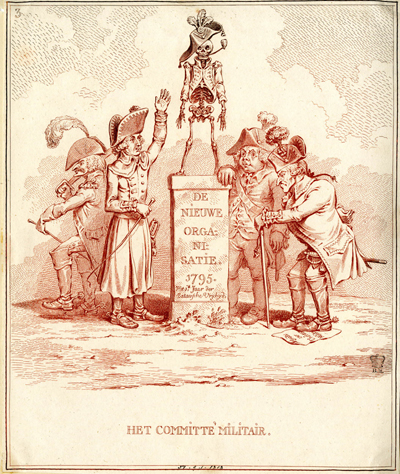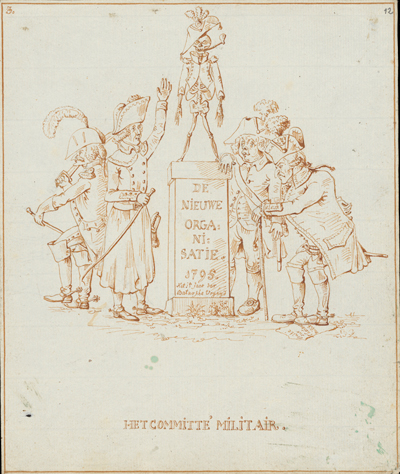Het Committé Militair
This is the third plate of a twenty plate series, Hollandia Regenerata, etched by Gillray based on drawings by the Swiss soldier, painter, and caricaturist, David Hess. For more about David Hess, and the political and artistic context of the series satirizing the newly-created and French-supported Batavian Republic, see my Introduction.
The title can be translated as "The Military Committee." Four men stand around a statue of a skeleton on a pedestal dressed in military uniform with a Dutch clay pipe in his mouth. The inscription on the pedestal reads: "New Organization. 1795. The 1st Year of Batavian Freedom. "

Het Committé Militair
[1796?]
© Trustees of the British Museum
According to Joost Rosendaal whose "Nawoord" to the 2007 facsimile edition of Hollandia Regenerata is essential reading for anyone interested in the series, the man with his arm upraised, as if showing off the statue, is likely General Herman Willem Daendels, who was responsible for the reorganization of the military after the proclamation of the new Batavian Republic. The old soldier on the right trampling on a paper bearing the title "Treaty of Military Honor ('Traité sur l'honeur Milita[ire]') is almost certainly, according to Rosendaal, Colonel Rogier Sulyard de Leefdael, who fled to France in 1787 after 50 years of military service to the former United Provinces.
As with all the plates in the series, the corresponding page to the image contains one or more appropriately ironic Biblical quotations in Dutch and English and a satiric "Explanation" in French. The Biblical quotation is as follows:
Jeremiah, xlviii. 14. "How say ye, we are mighty, and strong men for the war."
Here is the French text of the "Explanation."
Quatre heros autour de leur ouvrage, la nouvelle organisation de l'armée. Il est vrai que pour le present ce n'est encore qu'un pauvre squelette, sans muscles, sans chair, sans peau, sans chaleur, et sans âme; mais-qui sait ce qu'avec le tems ça peut devenir? Il a pourtant un bel uniforme à la Française, et un chapeau à la grénadiere. Ceux qui ont ete en Hollande, reconaitront aisément le Général S. qui se trouve au nombre de cette vaillante compagnie, ne fut-ce que parcequ'il foule a ses pieds un traité sur l'honneur militaire.
And here is my free English translation.
Four heroes stand around their work: the new organization of the army. It is true that, for the present, that organization is but a skeleton, without muscle, without flesh, without skin, without heat, without spirit. But who knows, over time, what it will become. It has a beautiful uniform and the hat of a grenadier. Those who have been in Holland will easily recognize General S among the number of that heroic company, if only because at his feet he tramples a treaty of military honor.
Like other countries in the 17th and 18th centuries, the Dutch relied on a substantial number of mercenary soldiers to do their fighting for them. Treaties or contracts between the Dutch and the home countries of the mercenaries spelled out the terms of their support, their pay, their honors. David Hess and his Swiss Guard were among the soldiers hired by the United Provinces, but after the flight of the Stadtholder, William V, the Provisional Representatives of the new Batavian administration decided to dismiss the mercenary troops, leaving what Hess suggests in his "Explanation"is but a "skeleton" crew of an army "without muscle, without flesh, without skin, without heat, without spirit." The Biblical quotation from Jeremiah is of course terribly ironic, and indeed from Hess's point of view almost prophetic, since a battle using a skeleton army is likely to result in further skeletons. But the dismissal of Hess and his Swiss Guards is not only foolish, he would argue, but represents an abrogation of the treaty of military honor established between the government and his Swiss canton.
As in most of the plates of Hollandia Regenerata, Gillray follows the Hess's drawing very closely. The disposition of the figures and the details and meaning of the print all derive from Hess, but Gillray has once again sharpened every line and especially the key figures. The introduction of shading and clouds in the background, for instance, now makes the skeleton soldier stand out much more vividly. And by shading the two minor figures, Gillray strengthens and highlights, by contrast, the figures representing Daendels and Sulyard de Leefdael.

Het
Committé Militair
[1796?]
© Zentralbibliothek Zürich
Sources and Reading
- Commentary from the British Museum on Het Committé Militair.
- "Batavian Republic," Wikipedia
- "David Hess (painter)," Wikipedia
- "David Hess," SIKART Dictionary
- David Hess, Hollandia Regenerata (1797), Nawoord by Joost Rosendahl, Uitgeverij Vantilt, 2007
- "Herman Willem Daendels," Wikipedia
Comments & Corrections
NOTE: Comments and/or corrections are always appreciated. To make that easier, I have included a form below that you can use. I promise never to share any of the info provided without your express permission.